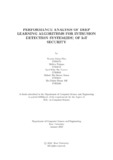| dc.contributor.advisor | Hossain, Muhammad Iqbal | |
| dc.contributor.advisor | Bin Ashraf, Mr. Faisal | |
| dc.contributor.author | Fiha, Yeamin Jahan | |
| dc.contributor.author | Farjana, Mithila | |
| dc.contributor.author | Bin Masum, Syed Rifat | |
| dc.contributor.author | Soron, Mehedi Bin Sarwar | |
| dc.contributor.author | Alif, Mia Fahim Hasan | |
| dc.date.accessioned | 2022-09-13T09:16:14Z | |
| dc.date.available | 2022-09-13T09:16:14Z | |
| dc.date.copyright | 2022 | |
| dc.date.issued | 2022-01 | |
| dc.identifier.other | ID: 17101475 | |
| dc.identifier.other | ID: 17201042 | |
| dc.identifier.other | ID: 17201063 | |
| dc.identifier.other | ID: 17201064 | |
| dc.identifier.other | ID: 17301206 | |
| dc.identifier.uri | http://hdl.handle.net/10361/17213 | |
| dc.description | This thesis is submitted in partial fulfillment of the requirements for the degree of Bachelor of Science in Computer Science and Engineering, 2022. | en_US |
| dc.description | Cataloged from PDF version of thesis. | |
| dc.description | Includes bibliographical references (pages 41-43). | |
| dc.description.abstract | The Internet of Things (IoT) is a term that refers to billions of actual gadgets
all over the universe that are connected to the network, participating in all social
events, and sharing data. It is the most recent technological advancement in history.
In addition, Internet of Things devices have sensors and small PC processors that
generate applications based on the data gathered by the sensors through Artificial
Intelligence (AI). Fundamentally, Internet of Things (IoT) devices are more modest
than anticipated PCs, are connected to the internet, and are vulnerable to viruses
and hacking. Similarly, there are legitimate concerns about risks associated with
the expansion of the Internet of Things, notably in the areas of safety and security.
Nowadays, the intrusion detection system for Internet of Things devices is a critical concern. Entering the computer environment is an extremely dangerous and
unpredictable activity that has existed since the invention of computer technology.
Many security measures have been implemented over the past three decades, but
as technology has progressed, so have the threats to national security. Because the
world is increasingly reliant on computers, whether directly or indirectly, it is critical
to prevent potentially dangerous activities and attacks that could jeopardize com puter infrastructure. IDS and IPS are two often used security solutions to protect
computer resources, particularly those on a network. To create a secure Internet of
Things deployment, a variety of security principles need to be followed at each tier.
In this case, the impact of artificial intelligence on the internet security of Internet
of Things devices is likely to alter the traditional risk assessments. Aside from that,
the field of Artificial Intelligence (AI) is rapidly expanding, propelled by shifts in
neuron organization and deep learning. In addition to this, we have employed Deep
Learning Approach to detect the intrusion of IoT gadgets as well as other types
of intrusion. Deep Learning is a sub-sector of artificial intelligence and machine
learning (ML) that mimics the way the human brain works in terms of data pro cessing and making effective decisions. As a result, it is playing an important role
in the detection of intrusion from devices that are linked to the internet. The IDS
(Intrusion Detection System) of Internet of Things System utilizing Deep Learning
techniques is the subject of our thesis. Our article provides a complete analysis of
security policies, technical obstacles, and solutions for Internet of Things (IoT) se curity protection. In addition, we have employed two datasets, namely KDD-99 and
NSL-KDD, as well as three methods, including RNN, LSTM, and GRU, in our pa per. The proposed model was tested and evaluated as a consequence, and the results
demonstrate that the model is extremely accurate when it comes to distinguishing
interruptions in Internet of Things devices.. | en_US |
| dc.description.statementofresponsibility | Yeamin Jahan Fiha | |
| dc.description.statementofresponsibility | Mithila Farjana | |
| dc.description.statementofresponsibility | Syed Rifat Bin Masum | |
| dc.description.statementofresponsibility | Mehedi Bin Sarwar Soron | |
| dc.description.statementofresponsibility | Mia Fahim Hasan Ali | |
| dc.format.extent | 43 pages | |
| dc.language.iso | en_US | en_US |
| dc.publisher | Brac University | en_US |
| dc.rights | Brac University theses are protected by copyright. They may be viewed from this source for any purpose, but reproduction or distribution in any format is prohibited without written permission. | |
| dc.subject | Deep learning | en_US |
| dc.subject | Intrusion Detection System | en_US |
| dc.subject | IoT | en_US |
| dc.subject | Security | en_US |
| dc.subject | RNN | en_US |
| dc.subject | GRU | en_US |
| dc.subject | LSTM | en_US |
| dc.subject | KDD-99 | en_US |
| dc.subject | NSL-KDD | en_US |
| dc.subject | LSTM | en_US |
| dc.subject | GRU | en_US |
| dc.subject | IDS | en_US |
| dc.subject | Vanilla LSTM | en_US |
| dc.subject | Bidirectional LSTM | en_US |
| dc.subject | Stacked LSTM | en_US |
| dc.subject.lcsh | Machine learning. | |
| dc.subject.lcsh | Intrusion detection systems (Computer security) | |
| dc.subject.lcsh | Internet of things | |
| dc.title | Performance analysis of deep learning algorithms for Intrusion Detection System(IDS) of IoT Security | en_US |
| dc.type | Thesis | en_US |
| dc.contributor.department | Department of Computer Science and Engineering, Brac University | |
| dc.description.degree | B. Computer Science | |

